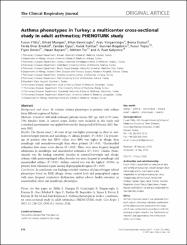Asthma phenotypes in Turkey: a multicenter cross-sectional study in adult asthmatics; PHENOTURK study

Göster/
Erişim
info:eu-repo/semantics/closedAccessTarih
2017Yazar
Yıldız, FüsunMungan, Dilşad
Gemicioğlu, Bilun
Yorgancıoğlu, Arzu
Dursun, Adile Berna
Erkekol, Ferda Öner
Oğuş, Candan
Türktaş, Haluk
Boğatekin, Günhan
Topçu, Füsun
Deveci, Figen
Bayram, Hasan
Tor, Meltem
Kalyoncu, A. Fuat
Üst veri
Tüm öğe kaydını gösterKünye
Yildiz, F., Mungan, D., Gemicioglu, B., Yorgancioglu, A., Dursun, B., Oner Erkekol, F., Ogus, C., Turktas, H., Bogatekin, G., Topcu, F., Deveci, F., Bayram, H., Tor, M., & Kalyoncu, A. F. (2017). Asthma phenotypes in Turkey: a multicenter cross-sectional study in adult asthmatics; PHENOTURK study. The clinical respiratory journal, 11(2), 210–223. https://doi.org/10.1111/crj.12326Özet
Background and AimsTo evaluate asthma phenotypes in patients with asthma from different regions of Turkey. MethodsA total of 1400 adult asthmatic patients (mean (SD) age: 44.0 (13.9) years, 75% females) from 14 centers across Turkey were included in this study and a standard questionnaire was applied between the time period of February 2011-January 2012. ResultsThe disease onset40 years of age was higher percentage in obese vs. normal/overweight patients and nonallergic vs. allergic patients (P<0.01). the percentage of patients who had FEV1 values over 80% was higher in allergic than nonallergic and normal/overweight than obese patients (P<0.01). Uncontrolled asthmatics have more severe disease (P<0.01). There were more frequent hospital admissions in nonallergic and uncontrolled asthmatics (P<0.01). Chronic rhino-sinusitis was the leading comorbid disorder in normal/overweight and allergic asthma, while gastroesophageal reflux disorder was more frequent in nonallergic and uncontrolled asthma (P<0.01). Asthma control rate was the highest (39.0%) in patients from Marmara region among all geographical regions (P<0.05). ConclusionIn conclusion, our findings revealed existence of clinical/trigger related phenotypes based on BMI, allergic status, control level and geographical region with more frequent respiratory dysfunction and/or adverse health outcomes in uncontrolled, obese and nonallergic phenotypes.

















